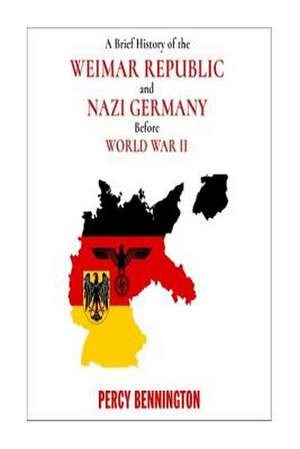A Brief History of the Weimar Republic and Nazi Germany Before World War II
Autor Bennington, Percyen Limba Engleză Paperback
German governments had teetered on the edge of collapse throughout the Weimar years, as politicians of all stripes had struggled to stabilise the economy and the wider societal problems. In the 14 years between 1919 and 1933, a total of 20 separate coalition governments had been formed. The most stable period, after the hyperinflation of 1923 and before the Wall Street Crash of 1929, was only calm in a relative sense. It is therefore perhaps unsurprising that the Weimar state was so easily dismantled by Hitler's National Socialists. What is more shocking, however, is the speed in which the Nazis turned a fragile democracy into one of history's most draconian dictatorships. The Nazis demonstrated both brute force and political guile, as well as highly effective propaganda, in achieving their aims.
There are many contradictions surrounding the transition from Weimar to Nazi Germany. The country had been home to some of the key figures of the Enlightenment Period, in arts, philosophy, music and literature. Yet this beacon of civilisation descended into an abyss of barbarism and intolerance. A region that for so long resisted incorporation into one state became intensely nationalistic. A country that provided refuge to Jewish people for hundreds of years turned on them to prosecute anti-Semitism's lowest point: the Holocaust. A state (Weimar) that had been designed with liberal and progressive ideals dissolved into illiberalism and reactionary authoritarianism. The alignment of Nazism and Germany is obvious to the 21st century reader but as it unfolded, the chain of events took the world by surprise. This period of history, fueled by Hitler and his fanatical politics, led the world to the bloodiest moment of an ultra-violent century. In January 1933, when Hitler became German Chancellor, all this was in the (albeit near) future. How the Nazis accumulated power is a true "warning from history."
A Brief History of the Weimar Republic and Nazi Germany Before World War II provides a quick but comprehensive look at the Weimar Republic and Nazi Germany before the war.
| Toate formatele și edițiile | Preț | Express |
|---|---|---|
| Paperback (2) | 64.04 lei 6-8 săpt. | |
| – | 64.04 lei 6-8 săpt. | |
| – | 76.15 lei 6-8 săpt. |
Preț: 64.04 lei
Nou
Puncte Express: 96
Preț estimativ în valută:
12.25€ • 13.10$ • 10.22£
12.25€ • 13.10$ • 10.22£
Carte tipărită la comandă
Livrare economică 18 aprilie-02 mai
Preluare comenzi: 021 569.72.76
Specificații
ISBN-13: 9781983946479
ISBN-10: 1983946478
Pagini: 44
Dimensiuni: 152 x 229 x 2 mm
Greutate: 0.07 kg
ISBN-10: 1983946478
Pagini: 44
Dimensiuni: 152 x 229 x 2 mm
Greutate: 0.07 kg
